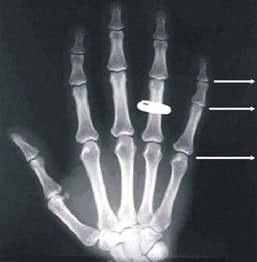Hands: Symptoms
The major clinical symptoms of osteoarthritis are pain and discomfort in movement. Symptoms appear for each affected joint, but their severity may vary depending on the latter. Onset of symptoms is usually gradual.
We talk about clinical signs (described here) and radiological signs (described in the radiological examination section), but the presence of clinical signs does not necessarily mean there are radiological signs. Hence, you can be suffering and your X-rays show only very slight osteoarthritic lesions and vice versa.
It usually affects the distal phalanges and its evolution is slow.
In general, symptoms consist of either an unsightly deformity, or a painful flare-up. The essential sign is the appearance of nodules (swellings) on the last joint, initially appearing first on the index, middle and little fingers with potential bilateralisation and spread to the other fingers. These nodules are called Heberden's nodes.
Involvement of the proximal interphalangeal joints is rarer. Nodules may also appear (Bouchard's nodes). This damage is often characterised by intense pain and local inflammation.
Sometimes cysts can form under the skin and crack, revealing a clear and thick liquid.
Lastly, involvement of the metacarpophalangeal joints is very rare.

Distal interphalangeal joints (DIP)
Proximal interphalangeal joints (PIP)
Metacarpophalangeal joints (MCP)
The pain is located at the base of the thumb. It is provoked by the act of pinching or squeezing. These can be limited to being slightly bothersome for fine movement but can also lead to problematic joint stiffness.
In evolving, the lesions may lead to deformity of the first phalanx of the thumb (the trapeziometacarpal joint moves, and the two bones of the joint are no longer quite opposite one another). This deformity can be disabling. Treatment is therefore required at an early stage to prevent this development.
Your general condition is always good.
There is neither fever nor weight loss. However, osteoarthritic lesions are irreversible and sometimes lead, in addition to deformity, to joint stiffness which may progress to partial infirmity.






